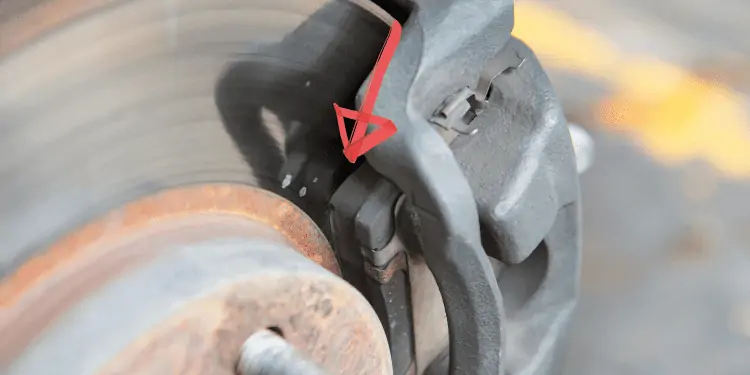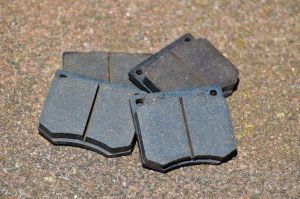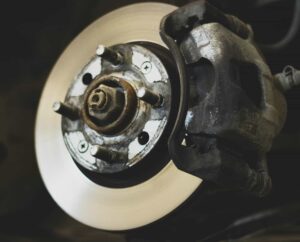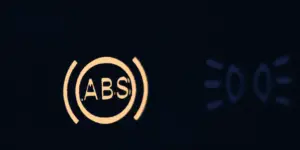It can be annoying when you’re trying to keep your attention ahead of you, but you’ve got a grinding noise from the back. Here we’ll examine the likely causes and the repair cost, if any.
If you’ve got grinding noises from a rear wheel, it is likely to be either brake or wheel bearing related. If your car is rear wheel drive or AWD, it could be a CV joint or a transmission fault on rare occasions.
So let’s start with the most likely causes first:
Brakes
Bedding In
A bit of a long shot, but let’s get the easy causes out of the way first.
New brakes do need bedding in. Have you had the brake pads on your rear wheels changed recently? If you have, expect the grinding to stop around the 100-mile mark since you changed the pads.
If you’ve had them changed and the noise continues over this period, it’s possible that something happened during the changeover.
Dust Debris
Each time we brake, a small piece of brake lining is lost from the pad. Usually, this gets dispersed in the atmosphere when we drive, sometimes though the dust can pool and collect along the calipers or rotors.
When the pads and/or rotors have been replaced, any contact with the dust shield, caliper, or rotor can cause this dust to resettle on the rotor. Most decent car shops will ensure that the area is completely free of dust before putting the wheel back on, but mistakes are made – we’re all human.
Worn Pads
The most likely cause is that your brake pads on one or both rear wheels are worn. Some pads last longer than others based on the quality of the material they’re made from and the driving they’re subjected to.
You might think that if worn, how can they make a metal scraping sound from a rear wheel? Wouldn’t they make no noise at all?
This noise comes from a metal wear indicator that rubs along the rotor when the brake pad is completely worn away. It’s meant to be annoying and is designed to let you know that you need to take some action.
Stone Lodged
This happens more times than you would think, especially if you spend a lot of miles on loose gravel roads.
Sometimes a stone or loose piece of gravel will find its way between the pad and the rotor. You’ll hear a constant grinding noise on the affected rear wheel until one of two things happen.
- The stone wears down – It’s not as tough as the metal rotor or the material – ceramic or otherwise of the pad – and falls out.
- You notice it and take it out before the sounds drive you nuts. It’ll be easy to spot. You may not see the stone itself, but you should see a scoring albeit faint – on the rotor where the stone has been rubbing. You don’t need to take the wheel off to see it. Look through the rim spoke or take the hubcap off if you have steel wheels.

Bent Splash Guards/ Dust Covers
Sometimes a dust shield takes a whack and gets bent into the rotor. Whether the brake pedal is pressed down won’t matter then, as the grinding noise will always be heard when you’re driving.
You should be able to see this through the holes, and if it’s rubbing, a screwdriver should give you enough leverage to remove the shield off the rotor.
Brake Caliper
Brake calipers do seize up in either one of two positions.
If they seize open, then you won’t hear a grinding noise – but you may notice a significant reduction in your braking ability
or the closed position. This results in the caliper forcing the pad onto the rotor whether the brake pedal is pressed or not.
One way to see if the caliper is sticking without removing the wheel is to look for a gap between the pad and the rotor when the brake pedal isn’t being pushed down.
There should be a few mm clearance as a minimum. If you can’t get the tip of a screwdriver between them, the caliper is likely seized.
Although the caliper is subjected to grime, moisture, and extreme temperatures at both ends of the scale, it can often be unseized and salvaged rather than needing to be replaced,
Rear brake calipers are often cheaper as they have one piston, as less force is needed to stop the rear wheels. Front brakes often have two pistons.
If the caliper can’t be unseized, expect to pay between $90 and $120 for a new one and an additional $100 to $160 in labor.
Parking Brake
Your parking or emergency brake is on a different circuit from the brake pedal in your car’s cabin. However, this circuit also uses the calipers, the rear rotors, and pads, albeit with much less force to stop a moving car.
The caliper can also be stuck in place by a fault in this circuit. This system works via cables while the stronger foot pedal circuit is powered hydraulically.
So that’s the brake-related problems covered. Now we can look at the other three causes.
Bearings
If we’ve ruled out a brake problem, the wheel bearings are the most likely part to fail.
Both back wheels have a set of bearings. Their job is to allow the wheel to rotate smoothly, but when the grease within the race that lubricates the ball bearings dries out, the metal ball bearings start to rub together. This creates a grinding noise.
If you have a jack, raise each rear wheel one by one. Hold onto the tire with both hands, one at 6 o’clock and one at midday – and then 9 o’clock and 3 o’clock as well and rock the tire back and forth. If it moves, then the wheel bearings need replacing.

Sometimes the wheel may be rock solid, but the bearings may still be bad. The next – and final test – is to rotate the wheel while it is still jacked up. If you hear a rumbling noise as the wheel turns, this is the bad bearings.
Wheel bearings can sometimes be salvaged, but there is little point in reality. A new set is cheap.
Expect to pay no more than $30 for a new one. A DIY mechanic can do the fitting, but a shop will charge you around $100 to replace them.
CV Joints
Is your car a rear wheel drive or an all-wheel drive vehicle? If so, then a CV joint may be bad.
If your car is a front-wheel drive, then CV joints aren’t on the rear axle, and you can disregard this.
Your car’s CV joints attach the transmission to the wheels through the driveshaft and the driveshaft. So there are four in total. In simple terms, the outer joints are the last piece in the line to pass on power to your wheels.
Without CV joints, your car is going nowhere.

As the drive shaft is inflexible, but the wheels always have some play, these joints allow the small movement needed that still ensures your car’s wheels get the power it constantly needs at all times.
Another symptom that they have gone bad is grease on the inside of a rear tire. If present, it has escaped from the CV rubber boot that encases the joint itself. You may also feel some vibration through the steering wheel too.
A DIY mechanic can repair CV joints. The outer ones are easier to get off and replace, while the inner ones may require removing the driveshaft and getting underneath the car. Not something everyone wants to do.
The CV joint part costs between $50 and $100, while labor will range from $100 to $150. Expect to pay between $150 and $250 in total.
Rear Differential
If your car is AWD or rear wheel drive, this is the final possible cause of the grinding noise you’re hearing.
The differential is a clever set of gears that allow each rear wheel to rotate at slightly different speeds when cornering or turning.
If these differential gears go bad, it’s an expensive fix.
Any slight deviation can create a range of noises depending on what part has failed. A grinding noise is normally associated with spider gears failing.
More often, the cause is a lubrication leak if you have a grinding noise and have a light brown fluid on the drive where the center rear of your car is parked is a differential fluid leak.
Luckily it’s the least likely of all the potential parts we have covered to fail.
The cheapest differential fix is stopping a leak by replacing the gasket on the rear diff if it has perished.

The gaskets are cheap and range from $10 up to $20. It’s the labor that costs money, though. Most car shops will quote you between three and five hours of labor.
Expect to pay anywhere between $175 to $500 depending on where you take your car, and the hours they quote to replace the gasket.
If there is damage to the gears and pins within the diff, expect a large bill. It is very difficult to estimate the repair cost as there are many moving parts, and high-end cars’ differential parts will cost a lot more.
As a rough estimate, you are looking at a bill of anywhere from $1200 to $2000 to replace your differential.
In conclusion
Wheel or hub bearing fatigue is typical for grinding sounds coming from your rear wheels. While hub assemblies are also responsible for securing the wheel and tire to the car, wheel bearings enable the wheel and tire rotation by helping lower the friction between the assembly and the wheel.




![Can Dirty Brake Fluid Cause Squeaky Brakes? [ANSWERED] DOT-3-Brake-Fluid](https://carzaza.com/wp-content/uploads/2023/12/DOT-3-Brake-Fluid-300x161.png)








